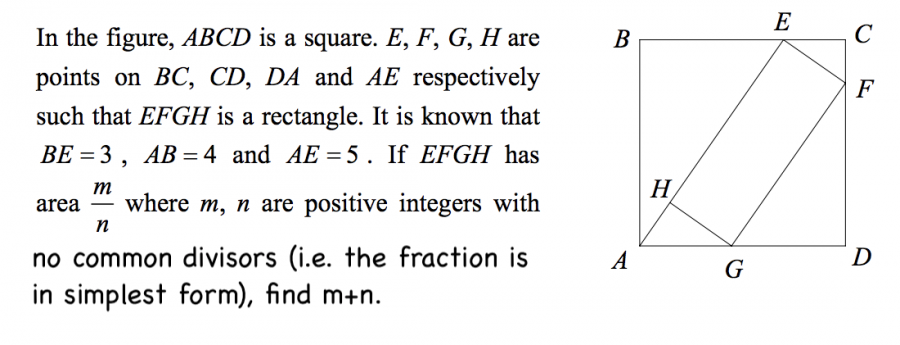Geometry Quiz. What is the answer for this exercise?

In the figure, ABCD is a square. E, F, G, H are points on BC, CD, DA and AE respectively such that EFGH is a rectangle. It is known that BE= 3, AB= 4 and AE= 5. If EFGH has area m/n where n, n are positive integers, with no common divisors (i.e, the fraction in simplest form), fin m + n.






Answers ( 1 )
This looks like a complicated problem, with seven lines of text (in two fonts!) to go with the picture. But as is often the case in these sort of geometry problems, the text is mostly just saying "it's exactly what it looks like" (it's a square with a rectangle inside it) and "now go find a value and show us you know it in a way that's easy for us to grade" (the answer will be a single number, and there will be no way to argue that some other number is equally correct).
_1597495645.png)
So the first thing to do is to recognize that those four triangles surrounding the rectangle look awfully similar in shape. If they all have the same three angle measures, then they will actually be similar -- and since angles B, C, and D are all 90 degrees (and angle AHG is the exterior angle of a rectangle, it's 90 degrees too). Good start! Now, whatever the measure of angle BAE is, the measure of angle BEA must be 90 - BAE (because the angles of a triangle have to add up to 180, always). Then we can tell that CEF is the same as BAE, because the three angles at point E have to add up to 180 (and angle HEF is 90), so CEF is 180 - 90 - BEA, or 180 - 90 - (90 - BAE), which is just BAE.
Very quickly, we can go around the diagram and see that all the smaller angles of the triangles are the same, which means all the other, medium-sized angles are also the same (and obviously, all the 90-degree angles are the same). I've marked all the right angles with boxes and all the small angles with curves in my diagram. The triangles are all similar, which means -- big important point! -- all their corresponding sides are proportional. They're not necessarily the same lengths -- the triangles are four different sizes, pretty clearly -- but they're proportional. If the short side of one triangle is three times bigger than the short side of another triangle, then the hypotenuse of the first triangle is also three times bigger than the hypotenuse of the other triangle. They're proportional.
And that's a big plus, because now we can just start scribbling down side lengths wherever we know them. I start with the ones they give us and then just keep going until I have the two sides of the rectangle, then multiply them together to give me the area, then simplify the fraction (that's what the "positive integers with no common divisors" thing means in the question's text), then add the numerator and denominator to get the answer. Note that I avoid mixed numbers wherever possible and use improper fractions like 16/5 and 65/16 -- that's good practice, in general.
Our final answer has a numerator that is 13 x 5 x 5 and a denominator that's 2^6, so there are no common factors to simplify away, so the final answer is just 325 + 64, or 389. Hope I got it right! :-D